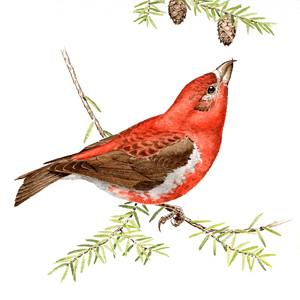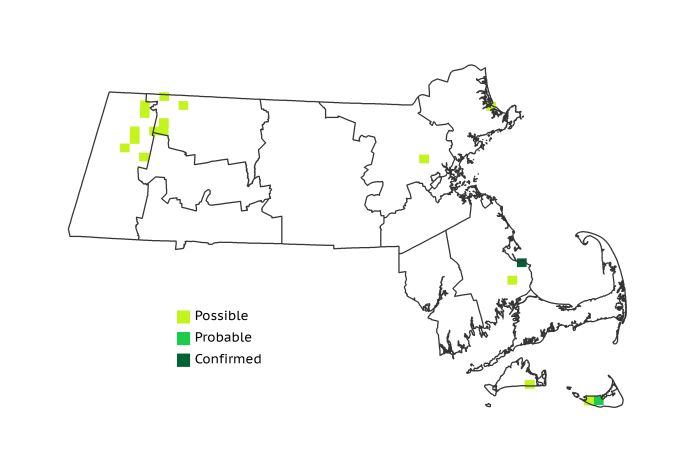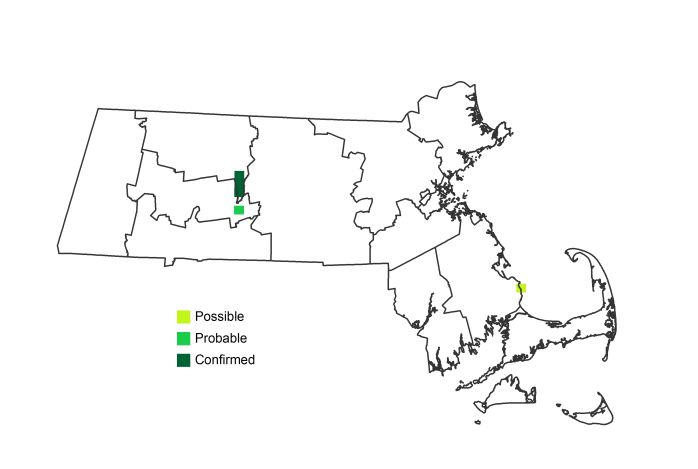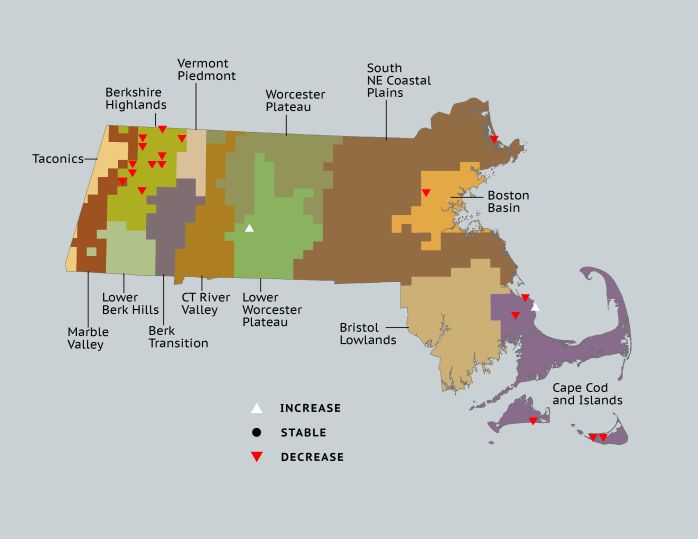Find a Bird
Red Crossbill
Loxia curvirostra

Very local, trend not established
“They call me the wanderer – yeah – the wanderer / I roam around around around around…” – Dion DiMucci, “The Wanderer”
Birds are, in many ways, defined by their relationships with their food. Perhaps no group of Massachusetts species exemplifies this effect better than the crossbills. Uniquely adapted to prying open closed conifer cones and extracting the seeds inside, crossbill populations are nomadic, irruptive, and show a considerable amount of variation. The Red Crossbill is the most common breeding species of crossbill in Massachusetts, but one may have a better chance of predicting New England weather than predicting where and when a Red Crossbill will show up.
Historic Status
Every once in a while a Red Crossbill would surprise the residents of nineteenth-century Massachusetts by appearing in the summertime. Henry Davis Minot wrote of their little-understood breeding habits. They preferred to remain above the 44th parallel, and “Hence they are sometimes not seen at all in Massachusetts during the year, and at other times they appear as early as August, and remain until June (whence it has been assumed they breed here)” (Minot 1877). A population crash after 1910, caused by logging in the states and provinces north of Massachusetts, only compounded the mysteries surrounding the species (Dickerman 1987).
Atlas 1 Distribution
Always nomadic and unpredictable, the Red Crossbill showed up in 18 blocks in Massachusetts during Atlas 1, and was Confirmed breeding in 1. Considerable conifer growth seems to be the common factor wherever this conifer-seed specialist appears. The Berkshire Highlands accounted for more than half of all the blocks where the species appeared, which is not surprising considering the region’s many high-elevation forests and its proximity to the Green Mountains of Vermont. Scattered sightings throughout the rest of the state, from the Boston Basin to the offshore islands, testify to the species’ tendency to show up in far-flung and unexpected places. The sole Confirmed breeding instance came from the mixed pine-oak forests of Plymouth, Massachusetts.
Atlas 2 Distribution and Change
One needs look no further than the Red Crossbill to find a species that is difficult to census. Nomadic and enigmatic early-season breeders that haunt the state in irruptive bursts, they show seemingly every character needed to make accurate trend estimation nearly impossible using Atlas protocols. Atlas 2 showed many fewer Possible locations for Red Crossbills than Atlas 1, although there were three Confirmations. The decline in Possible locations for this species is likely due more to the nomadic aspects of its behavior than a true decline in its status.
Atlas 1 Map

Atlas 2 Map

Atlas Change Map

Ecoregion Data
Atlas 1 | Atlas 2 | Change | ||||||
Ecoregion | # Blocks | % Blocks | % of Range | # Blocks | % Blocks | % of Range | Change in # Blocks | Change in % Blocks |
Taconic Mountains | 0 | 0.0 | 0.0 | 0 | 0.0 | 0.0 | 0 | 0.0 |
Marble Valleys/Housatonic Valley | 1 | 2.6 | 5.6 | 0 | 0.0 | 0.0 | -1 | -2.6 |
Berkshire Highlands | 10 | 18.2 | 55.6 | 0 | 0.0 | 0.0 | -10 | -18.9 |
Lower Berkshire Hills | 0 | 0.0 | 0.0 | 0 | 0.0 | 0.0 | 0 | 0.0 |
Vermont Piedmont | 0 | 0.0 | 0.0 | 0 | 0.0 | 0.0 | 0 | 0.0 |
Berkshire Transition | 0 | 0.0 | 0.0 | 0 | 0.0 | 0.0 | 0 | 0.0 |
Connecticut River Valley | 0 | 0.0 | 0.0 | 0 | 0.0 | 0.0 | 0 | 0.0 |
Worcester Plateau | 0 | 0.0 | 0.0 | 3 | 3.4 | 60.0 | 0 | 0.0 |
Lower Worcester Plateau | 0 | 0.0 | 0.0 | 1 | 1.3 | 20.0 | 1 | 1.9 |
S. New England Coastal Plains and Hills | 1 | 0.4 | 5.6 | 0 | 0.0 | 0.0 | -1 | -0.4 |
Boston Basin | 1 | 1.8 | 5.6 | 0 | 0.0 | 0.0 | -1 | -1.8 |
Bristol and Narragansett Lowlands | 0 | 0.0 | 0.0 | 0 | 0.0 | 0.0 | 0 | 0.0 |
Cape Cod and Islands | 5 | 3.7 | 27.8 | 1 | 0.7 | 20.0 | -4 | -3.3 |
Statewide Total | 18 | 1.9 | 100.0 | 5 | 0.5 | 100.0 | -16 | -1.9 |



